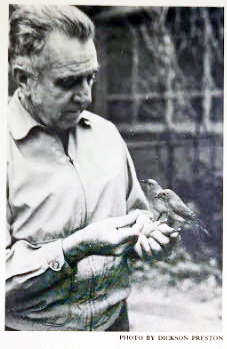
Dr. Lawrence (Larry) Zeleny (1904-1995) (pronounced ZEL-en-ee) is considered the grandfather of a movement to help bluebirds survive and thrive.
Dr. Zeleny was born in Minnesota on April 30, 1904. When he was just 14 months old, his mother used to park his stroller next to a bird bath. He claimed that one of earliest memories was that of bluebirds playing in the water.
He starting building bluebird nestboxes when he was just a lad. His first box used a design from a USDA pamphlet. With the proliferation of House Sparrows and then European Starlings, he became concerned with the plight of the bluebird. He found that, without constant vigilance and interference on his part (including use of a trap he bought from Joseph Dodson), House Sparrows nearly always evicted bluebirds from the nestboxes he had built for them. He wondered how bluebirds could possibly survive as a species without human help. (Source: The Return of the Bluebird, foreword by Zeleny, 1981)
Eventually he went on to earn a PhD in biochemistry from the University of Minnesota in 1930, and worked as an agricultural biochemist for the U.S. Dept. of Agriculture at the Beltsville Agricultural Research Center. In 1955, he put up a nestbox on the grounds outside his office.
After his retirement in 1966, Zeleny got permission to put up 13 nestboxes for bluebird research at the Beltsville Agricultural Center. He also bought 144 nestboxes and asked that they be placed around the state’s parks. The parks project was aborted due to vandalism (Source: Dr. Lawrence Zeleny, An Odyssey of Love), but his bluebird trail eventually spanned 10 miles in Maryland and Virginia. He began designing his own boxes with input from other birders like T.E. Musselman. He focused on the diameter of the entrance hole (1.5″) to allow bluebirds to enter but exclude starlings.
In 1968, he wrote a booklet entitled Bluebirds for Posterity. In a letter to the editor (The Capital, Arlington, MD), he wrote:
“The eastern bluebird, one of our finest and most useful songbirds, is in deep trouble almost everywhere. …[It] has disappeared in recent years to such an extent that without help its very survival may be at stake. … the bluebirds are unable to compete with the starlings and house sparrows that were originally brought into the United States from Europe and have now overrun the country in huge numbers. … The only practical solution to this problem is to supply the bluebirds with large numbers of starling-proof nesting houses….”
He also authored a monthly column for a nature society called “The Bluebird Trail” 1969 to 1981. In 1971, as president of the Maryland Ornithological Society, he implemented a program in Maryland where homeowners could register their property as a non-hunting wildlife sanctuary. In 1976, Dr. Zeleny published his first book on the plight of the bluebird, entitled The Bluebird – How You Can Help Its Fight for Survival. He estimated that the Eastern Bluebird population had declined by 90% over that period based on his own recollections and other friends of bluebirds who had lived long enough (From Bluebirds! By Grooms and Peterson).
An article he wrote, “Song of Hope for the Bluebirds,” which was published in the June 1977 issue of National Geographic, spurred nationwide interest in helping bluebirds. It was the first article in a large, general interest publication to highlight the bluebird’s plight. It resulted in a groundswell of support.
In 1978, he founded the North American Bluebird Society (NABS) and became it’s first president. By 1990 the organization had grown to more than 5000 members (Barbara Ruben, “He’s on the Trail of the Bluebird,” The Washington Post, July 12, 1990.) Dr. Zeleny had tried to get the National Audubon Society to support a national bluebird preservation effort in 1976, but they declined. At the time they were established, there were no state bluebirding societies. (Keith Kridler, 2006) He wrote many articles and columns in NABS quarterly journal, Sialia. He is also credited as the inventor of the Conical (Zeleny) Baffle.
Dr. Zeleny continued to monitor his 60+ bluebird trail on the grounds of the U.S. Dept. of Agriculture’s Research Center in Beltsville, MD until 1992. Larry Zeleny died on May 27, 1995, at the age of 91. (Source: NABS history)
The Zeleny Endowment Fund still supports bluebird research and education through the North American Bluebird Society.
More Information:
- The History of the North American Bluebird Society
- T.E. Musselman
- A Draft History of Bluebirds & Bluebirding
- Bluebirding Giants
Selecting a suitable location for the bluebird nesting box is of utmost importance.
– Dr. Lawrence Zeleny
